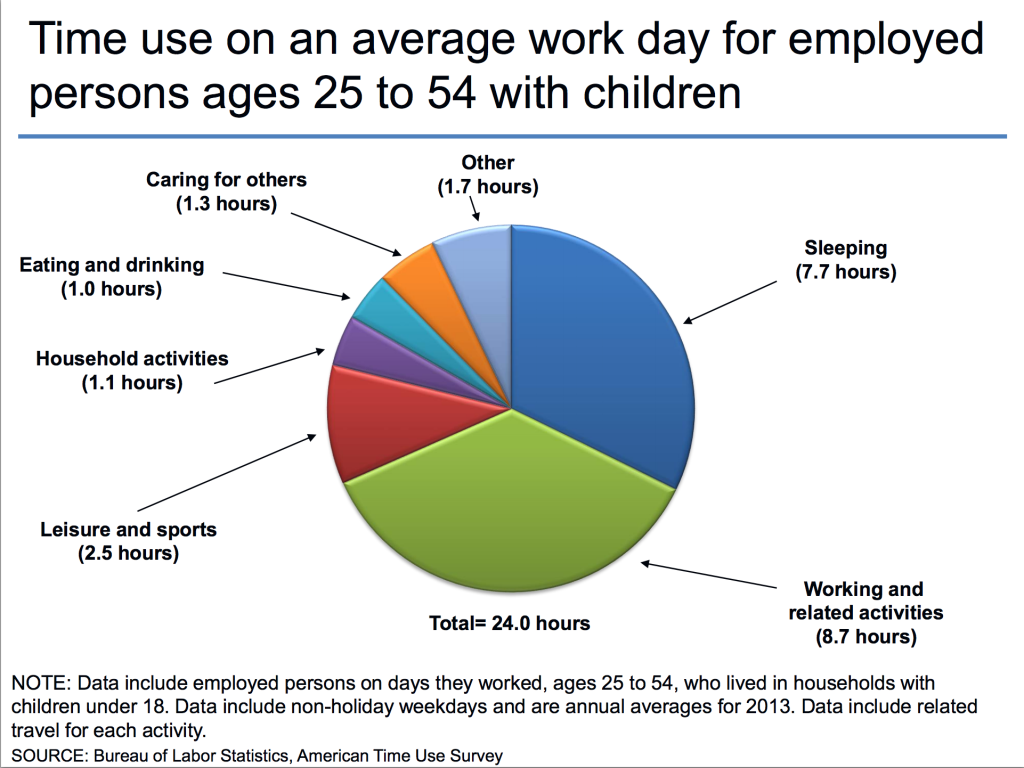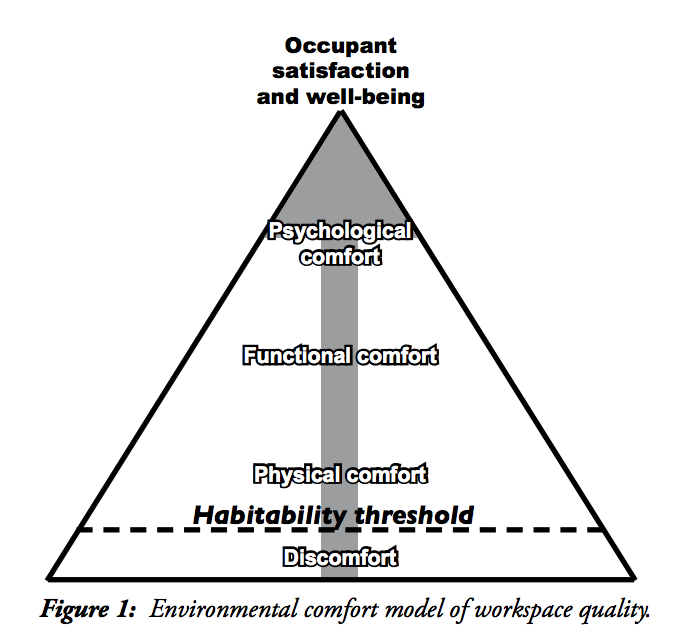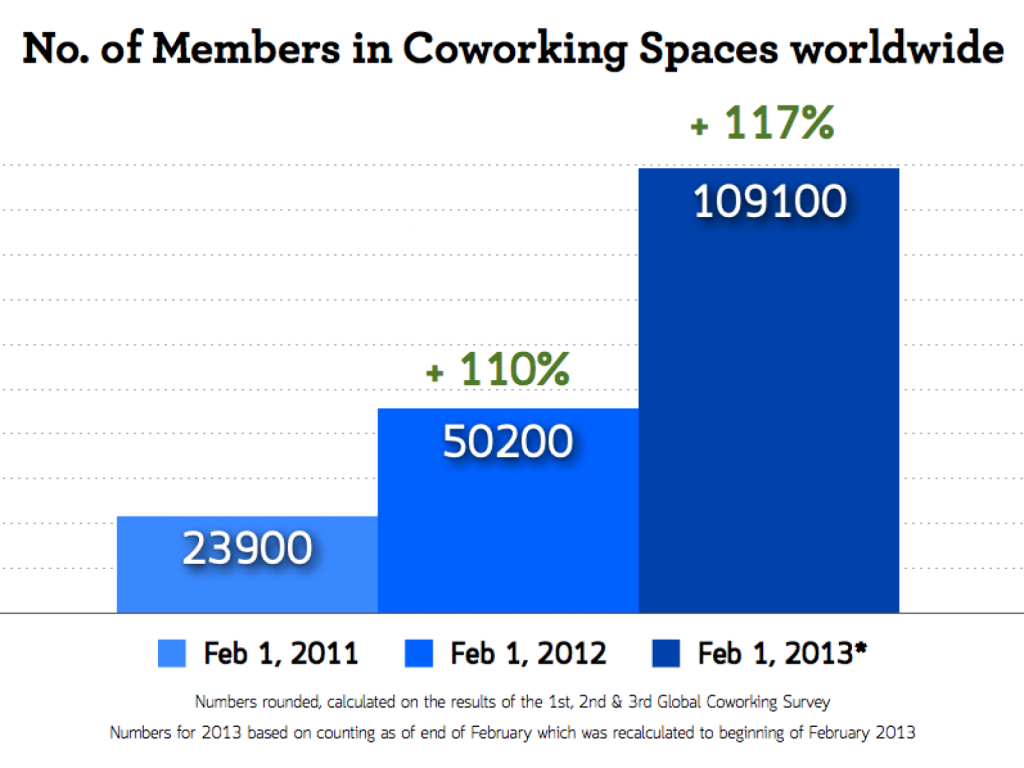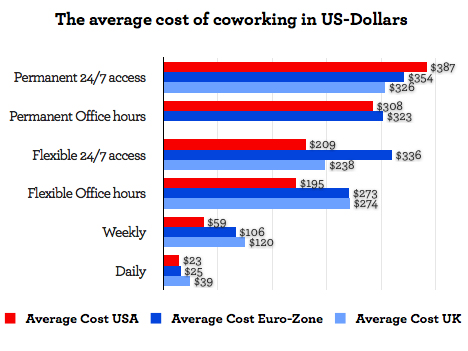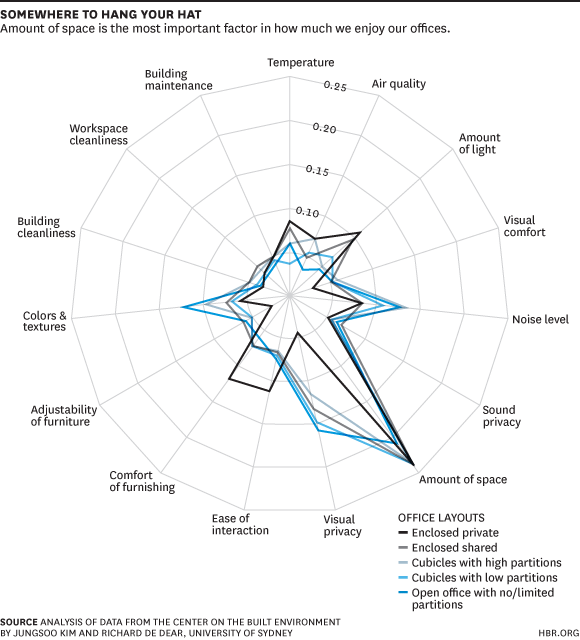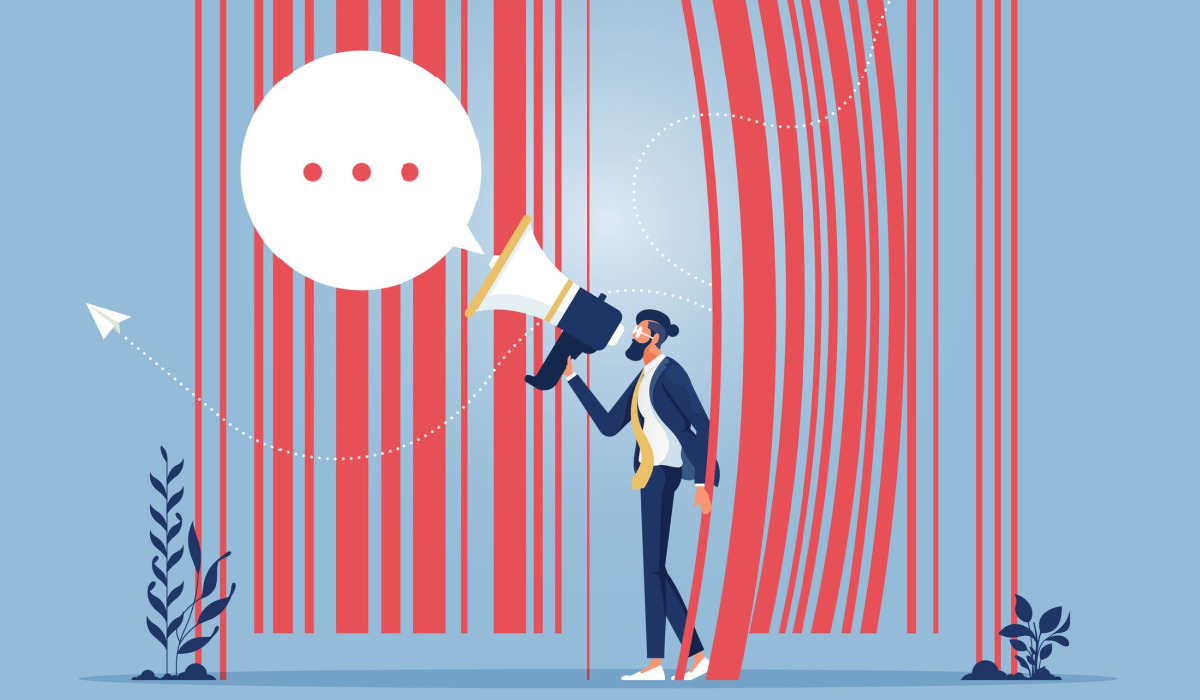Whether you’re a team, a corporation, a startup or a solopreneur, you need a place to work. But which is the best option? Like the businesses that fill them, offices come in different shapes and sizes and it’s important to find one that suit you and your business’s needs.
Information by the Bureau of Labor Statistics has found that the average worker spends just over a third of their day, 8.7 hours to be exact, at work. However a UK study has also found that entrepreneurs, on average, spend 63% more time at work clocking in anywhere between 53 to 62 hours in a week.
The point is, as an entrepreneur you’re going to spend the most of your waking life at work. Like investing in a good pair of shoes, or a good mattress, you’re going to spend the majority of your life in your office. So make sure it’s comfy.
You don’t want to look back and regret spending the majority of your life in a place you hate. After all, that’s why we all became entrepreneurs, so we can create the life that we want. If you’re going to master your destiny, then be sure to master your workspace.
Studies have shown that the environment you work in drastically affects your work performance. With trend-after-trend of the must-have gadget for your workplace, each swearing that it’ll maximize your productivity and creativity, it’s hard to decide which works for you or if they even work at all.
As a startup it’s unlikely you’ll find yourself working in any of these offices anytime soon. So let’s break down the three most popular places you’ll be able to find a bootstrapping entrepreneur.
The café, coworking spaces, and the home office.
Each have their own sets of pros and cons, so using the power of science and research let’s break it down and find out what really works and what doesn’t. Where should you, your team and your business discover your new home-away-from-home.
Environmental Psychology and You
It was only until recently that research into environmental psychology, the study of how one’s physical environment affects their behavior, has come into the vogue.
Up until that point there was a limited understanding of how physical space affected the human brain, the assumption being that as long as the basic physical needs were taken care of everything else would fall into place. Corporate spaces were designed with a factory mindset, a throwback from the industrial age. Workers were there to perform, not to think.
However businesses soon discovered that workers were unsatisfied with their current surroundings. While their physical needs were being met, emotionally they were in discomfort and the overall output was poor.
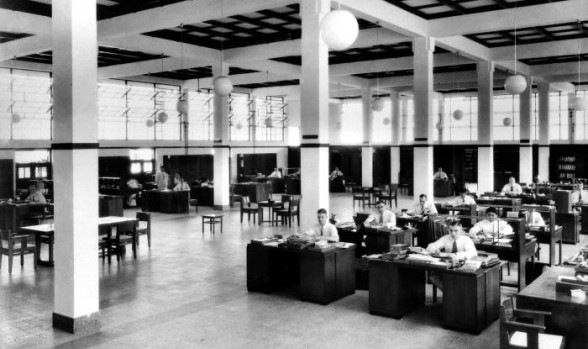
“When people feel uncomfortable in their surroundings they are less engaged – not only with the space but also with what they do in it. If they can have some control, that all changes and people report being happier at work, identifying more with their employer, and are more efficient when doing their jobs.” – Dr. Craig Knight, professor of social and organizational psychology at the University of Exeter.
An experiment conducted with over 600 programmers at over 92 different companies known as the Coding War Games found that the best workers outperformed the average by a ratio of 10 to 1. What was surprising by the results wasn’t that the most productive workers had the most experience or a higher salary. But those who performed at the top quartile reported a much more overall positive experience with their working environment than those who didn’t.
An extract from the survey of 600 programmers when asked to evaluate their workspace.
A 2013 report by Gallup has found that 70% of American workers are not engaged, or actively disengaged, at their workplace leading to a severe reduction in productivity. However the same report also finds that employees who were allowed to work remotely, on average, worked longer hours and showcased higher levels of engagement than their on-site counterparts.
As world becomes more interconnected and businesses are no longer constrained by the limits of space, workers no longer need to be confined to a single physical location. The rise of remote or mobile worker means that workers are now able to freely express their individuality and create the best working environment that caters to their own individual needs.
Further research into environmental psychology has found that everything from temperature to color affect our brain and work performance.
Here’s a neat infographic courtesy Taskworld about the effect color has on our work performance.
So now that we know that where you work affects how you work, where is the best place to get the job done?
The Café

Literary greats like Ernest Hemingway and Harold Loeb could often be found writing and discussing ideas in cafes and coffee shops around the world.
Research by the Northwestern University concludes that sensory distractions can actually be good if you’re looking to get creative work done. Having a mild level of noise and movement in the background actually forces your brain to be more aware of its surroundings, when that happens it becomes more open to new ideas for creative and innovative thought.
Further research has also found that ditching the headphones every now and then and just having everyday noise in the background can potentially boost your productivity. As long as your coffee shop isn’t overcrowded and blasting music through the speakers, a mild level of background noise is enough to stimulate your brain’s capacity to be creative.
Take a look at Coffitivity, an application that provides various high-quality recordings of the ambient background noise found in cafes and coffee shops, among other things, to help stimulate the creative juices.
Let’s not forget the endless ocean of the world’s most popular psychoactive drug available at your local café.
Caffeine has been proven to increase your energy levels, cognitive function and productivity. Along with added health benefits of reducing the risk of stroke, depression, and certain degenerative brain diseases, it’s easy to see why over 80% of Americans drink coffee daily.
Cafés also offer a unique opportunity to meet people and network, especially to get in touch with your local community. Many startups often get caught up and forget about the most important thing: the customer. It’s good to take a break from the office and remind yourself that people aren’t quantified by demographics or able to be labeled as something simple as ‘a target market’. Speak to staff and other patrons, it’s not only a great opportunity to gather valuable data but you’ll never know who you could meet.
If you’re an App Developer than you can take advantage of guerrilla testing with what Google calls the “Usability Cafe”. It’s based upon the premise of that it only takes 5 strangers to find out 85% of your core usability problems. It’s a simple premise where you ask patrons around the coffee shop to loan a few minutes of their time to help you by becoming a beta tester. Here’s a video from Google explaining how it works:
Outside of practicing proper etiquette of regularly ordering from the menu and tipping generously, coffee shops are a cheap alternative for entrepreneurs. However there are a number of downsides to choosing to work in a coffee shop.
It’s notoriously difficult to find a power point or electrical socket in any café. Unless you’re only looking to work a couple of hours then you’ll need to be sure to secure a spot, which isn’t always possible. Not to mention not all cafes supply WiFi, and the connection is often spotty at best. This is definitely a problem when business meetings over Skype are fast becoming a huge part of business.
Also the risk, however minimal, of digital and intellectual theft. Connecting to unsecured public WiFi networks puts any information you send over the internet at risk. If a hacker wanted to they could gain access to details such as your credit details, important emails and even personal information. The only way to prevent this is to practice proper cyber security.
However the biggest reason why you should avoid working in a coffee shop? It looks downright unprofessional. Unless you have an incredibly casual relationship with a client, having a meeting at a coffee shop is a bad idea. With the majority of Baby-Boomers and Generation X-ers deeming it an unprofessional environment. Your complete lack of control over the workspace will translate into a negative first impression in the mind of potential clients, making you appear incompetent.
Coffee shops are great if you’re looking for a casual break from the routine, and looking to get some solo work done. But as a permanent workspace, more often than not you’ll be dealing with more problems than just the dirty stares from the baristas not the exactly the best working environment.
If coffee shops aren’t for you but you’re still itching to get out, you’re in luck because there’s an abundance of public spaces where you can go and get work done. My personal favorite is to go to the local library, I find it has all the benefits of a coffee shop without any of the added distractions. Although thankfully when I’m from there’s no shortage of great cafes and coffee, so I’ll often rotate to different coffee shops depending on whether or not I need a change in environment.
Coworking Spaces
While the concept of open-plan offices have been around since the 1950s, the idea of a public access office which encouraged people to take advantage of its free WiFi and internet access didn’t happen until 1995. Berlin’s C-base was one of the first hackerspaces in the world with a focus geared toward computers and technology. Programmers and workers were invited to work in a collaborative open-plan office to share ideas and foster a sense of community and support.
Ever since Bernard de Koven coined the term “coworking” in 1999 based upon the idea of “working as equals”, coworking spaces have grown in popularity. From coworking spaces with childcare services to mobile collaborative offices, coworking has revolutionized the way we view and do work.
A report released by deskmag predicts that there will be over 12 thousand coworking spaces by 2018, supported by the fact that 2013 saw a 117% jump in membership in coworking spaces and the number continues to grow. It’s clear to see that coworking isn’t just a trend, but indicative of the workplace of the future.
Coworking spaces seem to be the perfect fit for entrepreneurs, providing the community and amenities of corporate culture while still maintaining the flexibility and freedom of a home office. All the while offering a relatively cheap and affordable rate depending on your needs, especially when compared to the high costs of renting out office space all by yourself.
Many notable entrepreneurs have been found at coworking spaces. Etsy founder Chris Maguire, Brainpicker founder Maria Popova, and Facebook co-founder Chris Hughes have all been spotted at New York coworking spaces. Foundr itself is based out of Revolver Creative, a incredible space based in Melbourne, Australia. As we’ve written about before startups and entrepreneurs can benefit incredibly from coworking spaces.
The main reason why coworking spaces are becoming so popular though? The absolute smorgasbord of professional talent you can come across. Coworking spaces ensure that you’re guaranteed to meet professionals, majority of them freelancers, from a wide range of professions and disciplines. You might even find your next colleague or client at a coworking space, I’ve personally met many of my clients through coworking spaces.
What you have is a unique opportunity for a cross-pollination of ideas. By being open and interacting with other professionals you’ll find your own creativity improving simply by being exposed to so many different ways of thinking.
“Psychologists generally believe that creativity almost always involved combining, building upon, and transforming pieces of information.” – David Harrington, professor of psychology at University of California.
The main complaint leveraged at coworking spaces, however, is that the majority operate primarily with an open-office layout.
The problems that existed 50 years ago still plague us today.
While it is true that your creative capacity grows with mild distractions, it has also been proven that it’s disastrous to our ability to focus and has detrimental effects to our short-term memory. Constant visual distractions severely hinders our ability to concentrate and to work productively.
Regardless of age, experience, or ability to multitask the more sensory inputs we’re exposed to, the harder it is to concentrate.
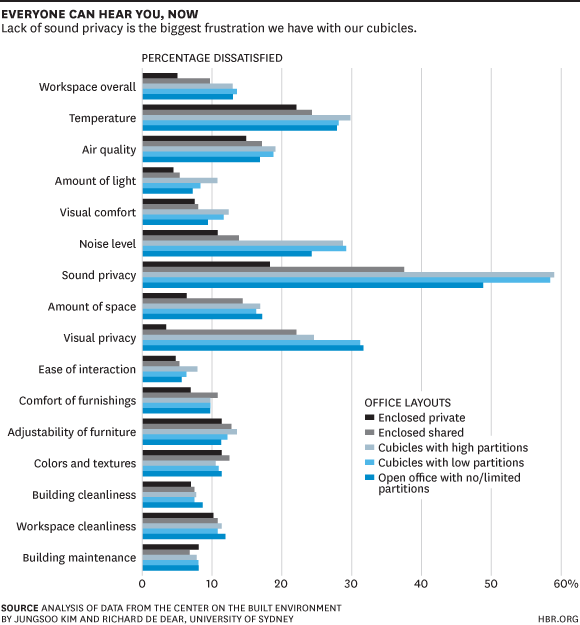
Another recent study of over twenty-four hundred employees in Denmark has also found that open-plan offices could even be detrimental to our health. Finding that those who work in open-plan offices were, on average, 62% more likely to call in sick when compared to those who worked in their own individual office.
But that doesn’t mean you should give up on coworking spaces. Thankfully not all are built the same, it’s just a matter of finding one that provides the appropriate amount of privacy, sound proofing and a recognized communal area.
Use databases like Workfrom, or CreativeSpaces, if you’re based in Australia, to find the best coworking space for you. Of if you like a more personal touch try out Hoffice, an innovative spin on coworking from Sweden where instead of going to a large coworking space you can rent out a desk at someone’s home.
Home Office
Working from home sounds perfect. You save money, have complete control over your domain, and who can say no to casual Friday every day? But, like with anything else, you only get as much as you put in. But before you head down to the nearest Ikea here’s how to make the most out of your home office and how to avoid the traps that seek to disrupt your business.
Research by the Office for National Statistics has found that 1 in 7 people in 2014 work primarily from home. Part of a growing trend where more and more people are looking to work remotely.
One of the greatest benefits of working from home is that you are able to exert full control over the space and ensure that you have the best working environment possible. You can ensure that your workspace compliments each and every one of your individual needs without needing to worry about how you might be affecting someone else.
Research was conducted by the University of Exeter in order to ascertain the link between workers and their workspaces. What they found was that workers who possessed full control over the design of their workspaces showed a 32% increase in productivity and proved to be happier and more motivated to work.
According to results published by the University of Sydney the most important factor in how much we enjoy our offices is the amount of space we have.
Do your best to fill your home office with natural light opposed to artificial light. Natural light has been proven to keep us more awake and motivated to work, as well as regulate our sleeping patterns leading to overall improvement in sleep quality. Workers demonstrate a significant improvement in productivity and performance due to the cumulative effect of sunlight and better sleep quality.
Recent research also advocates that you should introduce live plants to your workspace. Three separate experiments undertaken by research shows clear evidence that plants provide a positive psychological effect on workers. Reducing mental distress, improved cardiovascular function, and improvements to focus and attention.
Take a look at Pat Flynn’s setup for his home office for some inspiration.
But working from home is a double-edged sword. The lack of distinction between work and home life can prove to be detrimental to your work performance and wellbeing. A 2012 study by University of Texas found that people who work outside a traditional office often feel isolated, cut off from opportunities to socialize and network, distracted, and unsatisfied with the work and home life boundaries.
“I value self-discipline, but creating systems that make it next to impossible to misbehave is more reliable than self-control.” – Tim Ferris.
It’s important to create separate habit fields for different rooms and items. Habit fields are set attitudes, memories and habits that we associate with a specific item, this is known as declarative memory. Think of any time you’ve held onto a gift from a loved one, or a souvenir from a trip.
Just like memories certain mindsets and habits can become associated with an item. Because your home is a place of relaxation and comfort you’ll find it harder to switch gears to do work because you’ve never built up the habit of working in that space.
Take advantage of this knowledge and create a system where a certain area or items are designated for work and work only. Create a system where there is a clear separation for what is work and what is for relaxation and do your best to ensure that the two never mix. A neat trick I like to use if I’m working from home is to ensure that I have a small commute in order to get myself in the right headspace to work. Even if it’s just 5 minutes of going out to get a coffee it’s enough time for my brain to create the distinction that I’m leaving my “home space” and returning to my “workspace” by the time I get back.
One of the disadvantages of working from home is that there isn’t an official schedule for you to follow. Without a proper schedule to follow you might find yourself hours deep into work and burning yourself out without realising it. I can’t even count the number of times I’ve gotten so swept up with work that I’ve forgotten to eat. Try using TimeOut if you use a Mac, you can set up a custom schedule where it’ll remind you to take a break when you need it.
While there are a plethora of similar apps on the market, I personally like using Strict Workflow a Google Chrome extension which blocks certain distracting websites so I can focus on my work. It does so in conjunction with the Pomodoro technique, 25 minutes sprints of work with a 5 minute break after.
Take a look at some of these home offices courtesy of Zapier if you’re looking for any ideas and inspiration.
Conclusion
As businesses take further strides into the modern age workers are finding themselves more open, and able, to the idea of working remotely. No longer bound by the constraints of an industrial age mindset, the workplace of the 21st century is shaping up to look incredibly different to how it used to be a mere 20 years ago. How you and your business adapt to these changes is up to you.
The best working environment is made up a variety of factors that can affect our work performance. And just like everything else they’re not all created equal. Your job is to find the right kind of space that maximises your potential. As an entrepreneur if you’re going to be spending the majority of your waking life at work, ensure that you’re excited to go to work every morning. The best way to that is be working in a place where you’re constantly inspired.
Trying paying more attention to your surroundings and you’ll often find that you’re a reflection of the environment you choose to be in.
Now that you know what works and what doesn’t, experiment as much as you can and discover the most effective way to bring the best out of yourself. You’re not limited to only one option, the only limits are your imagination really the amount of time and energy you’re willing to invest into surrounding yourself with positivity, creativity and innovation.
Combine the right workplace with this list of productivity hacks to further improve your work performance and enhance your chances of success!
If you’ve enjoyed this article please do remember to like and share!

